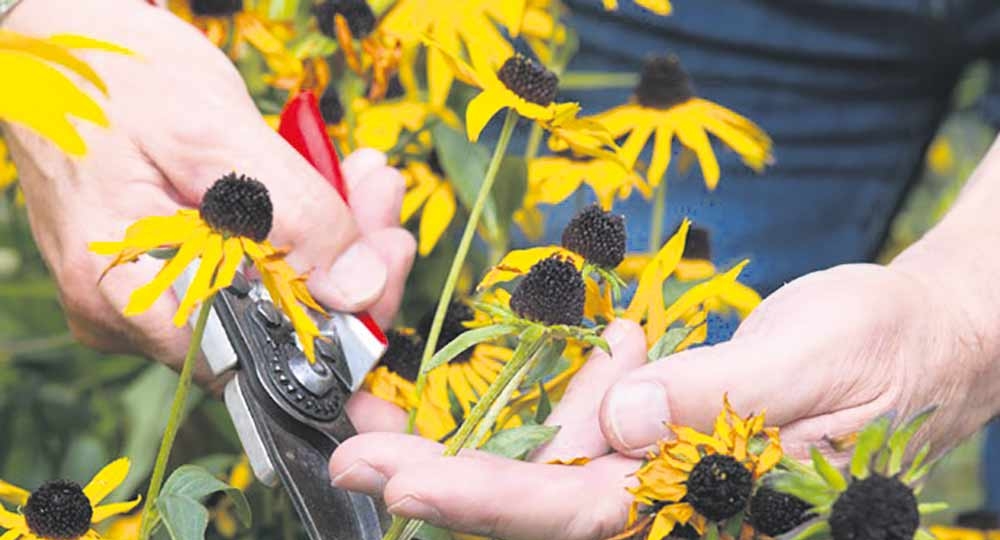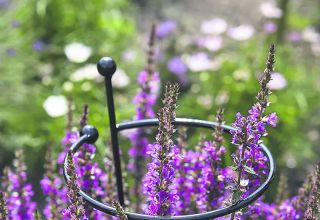There’s lots of pruning, deadheading and harvesting to be done in August, so if you’re off on your holidays make sure you get some help for your garden or plan ahead. Of course take time to enjoy the garden but gardeners never stop and it may be high summer but it’s also time to start preparing for the autumn vegetable patch and start to sow flowers for next spring.
Deadhead as much as you can
A key task for the month is to deadhead to try and keep all the colour blooming in the garden. You will be able to keep roses going with daily heading and that has to be a bonus.
Sweet peas, pelargoniums and cosmos will keep blooming if you deadhead them very regularly, thwarting any signs of a midsummer fade. When you go out watering take a bucket with you and get used to throwing in tired blooms.
Time for more broad beans?
It is possible to get a second crop of broad beans especially if the summer is good.
In late July and early August, when the broad bean plant has finished, cut down the stem close to the ground about 15 cms near a growing point and give it a feed.
On a good year it will re grow and produce a second, lighter smaller crop, but perfectly acceptable producing fresh broad beans in late summer/early autumn. It doesn’t cost you anything and with decent weather extends the season considerable.

Wasp alert
Wasps are a nuisance only late in summer when their queen stops rewarding them with sugary treats so they set out to find other sources, usually picnic-based. The rest of the year they are brilliant predators of garden pests. But if they are becoming too troublesome you can try a wasp trap from trapawasp.co.uk to draw them away from your picnic.

Its crunch time for caring for your tomatoes
August is often a critical time to make sure your tomato harvest is the best it can be. Damp weather can see blight appear and too often neglected tomato plants are allowed to waste their energy by producing masses of unnecessary leaves. On going tomato care is really important as the plants start to fruit. Even after pinching out the growing points to stop the tomato growing any taller, as tomatoes grow vigorously if allowed, you will need to keep on pinching out all top growth. The plant will keep growing, keep pinching out and removing leaves so all energy goes to the fruit.
This is also the most important time for regular watering and feeding to ensure a good crop of sweet tasting tomatoes. Without the right amount of water and feeding, there will be tomatoes, but of poor quality.
Mint cuttings for the winter
Take root cuttings of mint to keep you in indoor mint through the winter. Tip out of their pots and pull away a length of the thick white root that is snaking around the edge. Snip lengths a couple of inches long then lay them across the surface of a pot of compost, covered with a little of the same. Water and grow on a sunny cool windowsill.

Mow a meadow
Summer-flowering meadows can be cut now that knapweed, devil’s bit scabious, selfheal, lady’s smock and others have flowered and set seed. You need to plan for next spring’s show so cut everything down to cut to a height of around three inches. Leave what you’ve cut for a couple of days to dry and drop any seed, then rake up hay and remove it. Low fertility is key to success, so never mulch with grass clippings.
Keep lavender at its best
Give lavender plants a light trim all over as soon as the flowers are past.
This is important to keep the plant heavy and not too woody. Like all silver leaved, Mediterranean shrublets they hate to be pruned back into dead wood, so you need to keep them trim and neat with an annual going over. Use shears and take off just an inch or so of this year’s growth, to stimulate bushing out from below.

Dry out onions properly
If there is a decent dry spell, onions and shallots can be left on the ground to dry. It is important that before you put onions into storage they are bone dry. If they are even a little damp they will rot very quickly.
The greenhouse is idea for drying them off as you can
leave them on slatted shelving which is perfect for the job. Onions and garlic will store for 12 months in the right dry environment so it is important to get they really dry.
There’s still planting to be done
Plant foxgloves, sweet rocket, sweet williams and pernennials so the roots have time to establish themselves and put on lots of growth before the autumn.
Plant out your leeks and brassicas and you can also squeeze in a final sowing of spinach and chard in the first couple of weeks of August.
Sow salad leaves under cover, or out in the open if in warmer parts of the UK.
Another problem to keep an eye out for is blossom end rot on your tomatoes. This is first spotted on the fruit itself, as a brown or black spot that grows in size and gradually becomes sunken and flat. The risk of blossom end rot can be prevented by frequent watering – the disease being caused by the plants not receiving a sufficient quantity of calcium.
Do a last sowing of beetroot – a patch of a purple variety such as ‘Boltardy’, a stripy pink and white, such as ‘Candy Stripe’, and an orange such as ‘Burpee’s Golden’.
Plus
- Watering is key. Keep on top of this daily, making sure you water in the morning or late afternoon-evening to prevent the heat evaporating all the water before it reaches the plant roots.
- Continue mowing but reduce frequency and raise blades if the weather is hot and dry. Keep watering new lawns; established lawns will soon recover when it rains.
- Now is the time to look at your borders and note any gaps/congestion that you’ll want to rectify later in the season when everything has gone over, ahead of next year.
- Order spring flowering blubs. Stock of popular varieties may not be available later in the season. You can start planting bulbs such as narcissi, alliums and hyacinths from September. Order autumn stock of perennials to get them settled before the winter.












